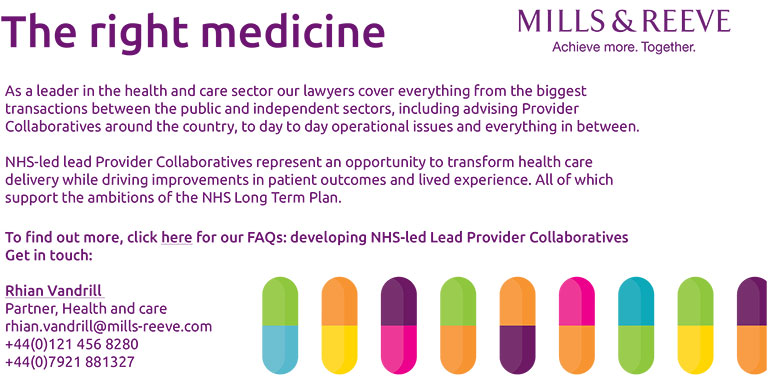 NHS-led lead provider collaboratives represent an opportunity to transform health and care delivery. Mills & Reeve Partner Rhian Vandrill shares insights from her experience of working with provider collaboratives on what makes a successful collaborative – the honeymoon can fade fairly quickly as you get down to the difficult issues.
NHS-led lead provider collaboratives represent an opportunity to transform health and care delivery. Mills & Reeve Partner Rhian Vandrill shares insights from her experience of working with provider collaboratives on what makes a successful collaborative – the honeymoon can fade fairly quickly as you get down to the difficult issues.
Several elements are key but here we identify what the most important considerations are when developing a new Provider Collaborative. We have outlined 10 key design principles.
Choose your partners carefully
The first step for providers is to work with others who share a similar vision, culture and ethos. Often existing relationships will make for a good partnership as you will have a shared history of other joint working or partnering.
Provider representatives
Providers must decide which person at each organisation will have responsibility for developing the provider collaborative. The provider representative must have sufficient delegated authority and seniority to make decisions on behalf of the provider, and ideally, the chosen representatives will attend every workshop in order to ensure continuing progress in the collaborative’s development.
Define your priorities
Providers will need to consider the overall aims and objectives of the collaborative. This means thinking about the reasons and incentives that organisations have to enter into the collaborative in the first place, their ultimate goals and what they are actually seeking to achieve together.
Governance model
Providers need to be clear and transparent on their chosen governance model, including agreeing on the voting and decision-making structure of the collaborative.
Lead provider role
Providers will need to work out and be very clear on what exactly the role of the lead provider will be within the collaborative. Just because a provider is the “lead provider” does not necessarily mean it can impose its own view on other providers with whom it sub-contracts.

Financial risk and opportunity
Providers will also need to plan and agree on how to deal with and “risk and gain” share agreement. Often any financial surplus is reinvested into the system in order to improve the service and ultimately benefit patients. How any financial deficit should be shared is usually a sensitive and contentious matter that needs careful thought.
Prepare a clinical model
It is essential for the collaborative to prepare a clinical model in order to work out how care will be delivered in a better and more cost-effective way, in order to improve the experience of patients and staff.
Competition law
Competition law applies to “undertakings” which includes NHS and independent sector providers. Undertakings are organisations that place goods or services on a market, so called “economic activity”. This is the case regardless of the nature or ownership of the organisation, be it private or public sector, profit making or a “not-for-profit”. Providers must not act anti-competitively (for example price fix) and need to be particularly careful about the exchange of sensitive commercial information between each other.
IP clauses in a collaborative agreement
Providers will also need to think about the IP position, such as what will happen where a provider leaves the collaborative after developing or contributing to new ideas or concepts. Will the provider be able to take this IP with them or does it remain with the collaborative?
Equity and equality
Providers will need to bear in mind how different types of provider organisation operate, and take this into account when deciding how they will be treated within the collaborative and how this might affect the contractual structure.
More Information:
Rhian Vandrill’s profile: https://www.mills-reeve.com/people/rhian-vandrill
Email address: Rhian.vandrill@mills-reeve.com
Webpage: Health and Care: https://www.mills-reeve.com/sectors/health-and-care









